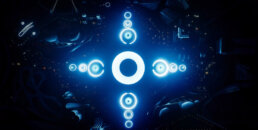HOW WE THINK
Science Fiction Thinking is an invaluable tool to begin any kind of digital transformation project. It is not intended to replace Design Thinking, rather it amplifies it and provides a framework and clear path forward. Ideas can be taken from design thinking workshops and then placed into a science fiction setting to see how far the idea can be taken in this new, futuristic universe. It allows companies to examine how innovations might be legitimately used, and through this process, measure their potential value.Below is Perception’s Science Fiction Thinking Process, outlined in 4 sensory stages.

PERCEIVE + DEFINE
At the very beginning, we want to listen very closely to understand the exact “story” we are looking to tell. We’re aiming to define all the users (characters), motivations, needs, desires, emotions, and use cases (plot points and storylines). From here, we need to define the problem by asking the right questions. It’s been said that if you want better answers, ask better questions. You can’t find a solution if there is no clear problem. By asking the right questions, we continually dive deeper and deeper into each of these aspects until we can fully understand the narrative we’re looking to tell. In this way, the entire team fully immerses themselves into this imaginary world. We have to buy into it and find the way in. We cannot proceed to Step 2 until and unless the problem has been fully ‘perceived’ and thoroughly defined. In some instances, a prospective initiative won’t proceed to step 2 if there is no real problem defined.

IMAGINE & ENVISION
This is where we get to let loose and begin to unleash our imaginations. What’s the story of your future? It’s important to free yourself from the shackles of your current reality—such as technological capability, current resource limitations or funding. This is a thought experiment of envisioning future societies and all the details that go into designing the “movie set” in your mind. Imagining it will be the first step in making it a reality.
This phase involves both creating (sketching, doodling, drawing, writing), and searching for inspirational imagery. Since this step is hinged on the sense of sight, there’s a complete emphasis on visuals here. Whether it’s original creations, images ripped out of books, pulled from websites, or sketches on napkins—the entire team needs to collectively envision these rudimentary conceptual ideas and ‘regions of interest.’ There could be multitudes of specific visual solutions to the problem, or a wide net auditing reference imagery from a vast universe of adjacent possibilities. If the team can’t ‘see’ it, the idea can’t move forward.

BUILD & CREATE
Now that an idea can be visualized and imagined, it’s time to give it form, so it can be felt and experienced. From the initial imagery created, it’s time to create what we refer to as experience prototypes. Here we fill out the world’s details, perhaps adding some characters to interact through scenarios and specific use cases. We create these prototypes to be as realistic and visceral as possible; we’re always looking to uncover the inner soul of the product and user experience. These prototypes are incredibly valuable conversation-starters about the specific technology and the future it will live in. By creating these roughed out experiences, we can explore the various futures we want to either avoid or move toward.
Throughout this entire phase, it’s important to keep asking questions. What is needed to enable this new world? Can any of these adjacent needs be fulfilled from your line of business? What would be the most astonishing manifestation of your product or service if money was no object? Keep asking the right questions, solving the puzzles and work backwards from the solution to arrive at what’s possible. One of our clients in the automotive industry is fond of saying that he “reverse engineers” science fiction. That is exactly the right mentality—begin with the end in mind and work backwards to discover the ‘how.’

INSPIRE & BELIEVE
It’s so real you can smell it, you can taste it. This stage is all about creating a powerful belief through the authenticity of experiencing the final prototype. The ultimate goal of the entire Science Fiction Thinking process is to create an end product that inspires—whether it’s inspiring decision makers to green light an initiative, or to become a rallying cry for a team of engineers to point to as their north star guiding them on their path for the months and years to come. Since it’s impossible to understand the future, so you must build your way forward to create it.
The experiences using these prototypes are also intended to play out certain outcomes and potential futures, inviting important discussions about repercussions and consequences. As with each preceding phase, constant questions are invited. Does the audience/user “buy it”? Would they want it? Is it aspirational? Did we inspire the decision maker(s)? Is it ambitious enough?

Measuring and testing throughout this process can lead to a much higher probability for success. It’s far easier and more cost effective to build these Science Fiction Prototypes then to go through the entire expense and cycle of building the real thing. The amazing part is the end result can be just as informative and instructional.
This entire process is a perfect feedback loop. At worst, the results from the process will reveal undesirable futures, or at best, the end result opens up potential areas for improvement, and the process can reset and begin anew.
Inspire, create, repeat.
